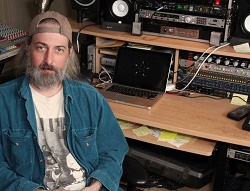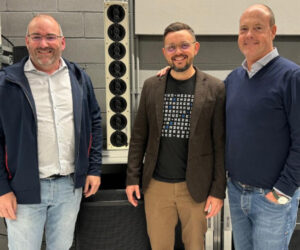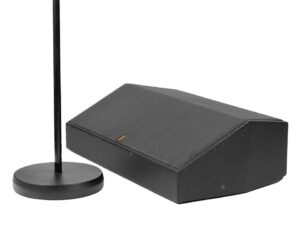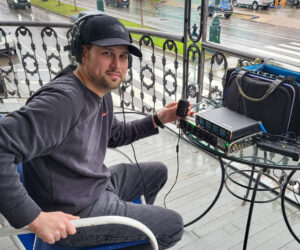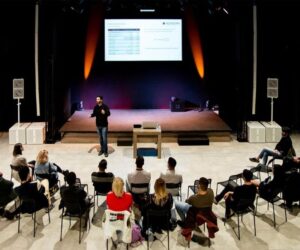David Kimmell has been mixing audio since 1997, and for many years mixed bands live, among other touring gigs. After several years in his own studio trying to mix ‘in-the-box’ and not enjoying it, feeling that he was “fighting the mix constantly,”
Kimmell added the Dangerous Music D-Box to his rig and everything changed.
“The light went on. I felt like, ‘This is how it should be,’ this is why I had so much fun mixing live, it just sounded good, and I didn’t have to fight anything,” says Kimmell.
Kimmell has mixed a wide variety of music styles over the past year at his Indianapolis studios, Masthead Audio, including tracks for the progressive rock group “Ladymoon” (where Kimmell recorded the band live and then mixed), the bluegrass groups “Whipstitch Sallies” and the “Flatland Harmony Experiment”, while in the EDM space he’s mixed and worked with “Digital Tape Machine” and “Turbo Suit”, and then there’s the experimental Hip Hop group “DAM!”.
Kimmell comments, “I like the variety. That was my favorite thing about mixing live, almost every show was completely different.”
“The D-Box and BAX EQ are both integral parts of my studio configuration,” Kimmell says.
“The basic nuts and bolts of my studio are a MacBook Pro running Digital Performer and Glyph hard drives, Waves, Melodyne, and other plugins, my hardware includes MOTU, Eventide, and Dynaudio and Yamaha monitors all with Mogami cabling. As far as how I use Dangerous Music gear, in short, it makes mixing fun again.”
Kimmell explains, “I come from the live world, and mixing on a killer analog desk is a joy. For years I tried to capture that feeling and reproduce it in the studio, but once I tried to mix everything down in the computer -in-the-box-it became work, and the joy was lost. When I got the D-Box it removed that wall. Now I have the best of both worlds. The power of the computer matched to the sonic chocolate that is analog, and that’s just the summing. Add in all the other features of the D-Box and it truly ties the studio together.”
Digging into his mixing experience with the D-Box he adds, “When mixing in-the-box, pretty much every time I’d add something into the mix I’d have to go back and change other things to make it work. Using the analog summing in the D-Box it alleviates that problem so I get back that give, the headroom, there’s not that brick wall at the top like there is in-the-box, in the computer. With analog summing I can just put up all the tracks and mix like I was used to doing. With the D-Box and analog summing: it sounds good, lets go.”
Kimmell uses the BAX EQ as the last stage in mixing before recording the stereo mix from the D-Box’s Sum Output back into his interface’s A-to-D.
“The BAX EQ is the next piece of the puzzle. Through mastering music of different genres I’ve found mastering plugins to be sterile sounding. The BAX reduces my need for plugin EQ correction while sounding infinitely cleaner and more musical than software EQ. Plus, the BAX’s high and low pass filters make the A-to-Ds color things less, giving me more accuracy in the conversion.”
Kimmell reveals, “I take the stereo mix from the analog summing into the BAX to clean up the signal and get rid of some of the artifacts at the bottom and the top, and put a little bit of sugar and shine on it, a little bit of punch before it goes back into the computer. I think that the BAX really helps the A-to-D converters work much more efficiently.”
“One of the other best things about having the D-Box is that I have an easy switchover to my other monitor set, plus I use the mono button to check the mix, it gives me some great options as far as monitoring,” he says.
Another favorite feature is the digital input, “I can actually monitor what’s going on when the mix is finished. I run stems of audio into the analog summing, the stereo mix comes out of the D-Box and into the BAX, and then back to my session through the A-to-D. I can listen through the D-Box’s onboard D to A converter for exactly what it sounds like-after the A-to-D, and after I’ve done some mastering to it. So I can hear more of what the final product is going to be. With one switch, I can listen between those two different things, I can tell where I am at with the analog summing and also listen to where the mix is at in the digital world. It lets me know exactly what’s going on-it’s a great tool to have. It makes mixing very simple.”
“Another benefit of the D-Box is that I have all those monitoring controls in one place,” adds Kimmell. “Like speaker switching, input monitoring for analog or digital inputs, and the headphone amp-which is definitely top of the line sounding!-it’s all in one unit. It used to be that the interface was the hub of the computer studio, at this point it’s the D-Box. It’s where I go first, I barely touch the interface anymore.”
On doing some basic mastering for his clients as well, Kimmell says, “I feel that an engineer should be able to give a client the entire process. From that first musical note to something they can put out to the masses. I think the ‘beginning to end’ cohesiveness is a part of what we’ve lost from classic recordings. To further that ideal I’ve begun to master more and more of my clients’ material-providing even more value to them. The BAX EQ really helps my mastering setup.”
Concluding his thoughts as a ‘wish list’ Kimmell says, “I can’t wait to get the Dangerous Compressor next. I wish I had everything Dangerous Music makes. [laughs].


